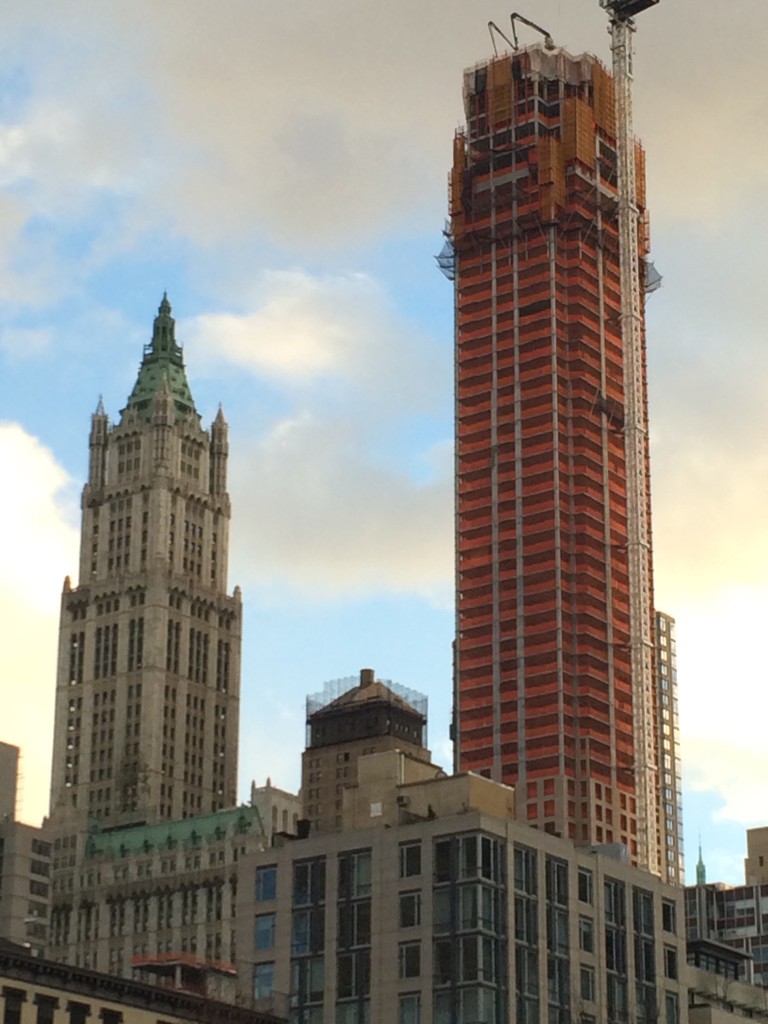We really need zoning reform.
The problem is simple: Big Real Estate has been allowed to run amok in NYC for too long. They toss up over-scaled high-rises right next to fine old neighborhoods. They attack the concept of zoning and the actual existence of historic districts. They tear down buildings that should be landmarks. They lobby incessantly to weaken the Landmarks Commission. They demand “fox guarding the henhouse” management of our regulatory agencies like City Planning, Landmarks, and the Bureau of Standards and Appeals (BSA). They pay for legislation to get tax incentives for luxury towers that destroy neighborhoods. They even demand rules for corporate welfare in the form of a guaranteed minimum rate of return from the BSA (Sugarman, 2010).
Their hubris is at times astonishing. I just heard Steven Spinola, former head of the Real Estate Board of New York, claim on the radio that real estate pays for all the police, firemen, and teachers in the entire city (WNYC, 2015). What manipulation! If you study the budget, you could just as easily say that our income taxes pay for police, firemen, and teachers.
But Big Real Estate is just doing what the zoning code allows. That code allows too many unplanned air rights transfers, encourages ill-conceived plaza bonuses, neglects the obvious need for height limits, rules out buffer zones around landmarks and historic districts, makes a mockery of meaningful community control over anything, and fails to provide a definition of “contextual” that would make sense to anyone.
To make a long story short, our zoning code fails to protect the public welfare. I am not the only one who thinks so. In 1999, then-Chair of City Planning Joe Rose made a speech to journalists urging reform of the zoning code. It is surprising given that he is a big real estate developer himself. The speech can be found on line now.
I have been studying Joe Rose’s neglected speech. I do not agree with all his proposed reforms. His characterization of preservation advocates is also profoundly wrong-headed to say the least. But at least he raised the problem. And many parts of his diagnostic are spot on. Here are some quotes:
“Density is not the problem” [Hear that, political leaders]
“We are in crisis because in many instances our zoning promotes an architectural vision that does violence to our urban fabric”
“The 1961 zoning changes imposed an aesthetic regime of “towers-in-the-park which has been proven to be a fundamentally flawed, anti-urban, and anti-New York concept.”
“The visual disorientation of urban towers needs to be ameliorated by a well-designed base that relates to the traditional cityscape”
“Zoning should respect the urban fabric and protect the quality of life. Neighborhoods should not be overwhelmed by inappropriate development.”
“Providing incentives to real estate developers to provide public open space on private properties produces largely unsatisfactory results”
“Views have become so prized that we unleashed an intense desire for building height without regard to neighborhood character or scale. Each new building tries to get better views by being taller than the last. The consequence has been a powerful inducement to break away vertically as far as possible from the neighborhood pack”
“While there is nothing wrong with nice views, it is not necessary to have a city shaped by a desperate grab for them.”
And last,
“For New York City, height limits are a radical step, but they are clearly needed.”
Thank you Joseph Rose for some great insights.
My vote is yea.
But I was told by someone in the know, that Joe Rose admitted in a private conversation that the Real Estate Board of New York killed off his ideas very fast – they lingered no longer than 30 minutes on the desk of the then-Mayor.
The situation has only gotten worse.
Sources
Alan Sugarman, “Lowering the Variance Bar: New York City Board of Standards and Appeals Further Eases Requirement for Variance Applications” November 4, 2010.
WNYC.org “Who’s Buying New York? series #2 “Tax Breaks Look Good 90 Stories Up” reported by Jessica Gould, Jan. 15, 2015.
Joseph Rose, “Reforming the New York City zoning Resolution” City Planning Commission, April 20, 1999. http://www.tenant.net/land/zoning/unifiedbulk/reforming.html



